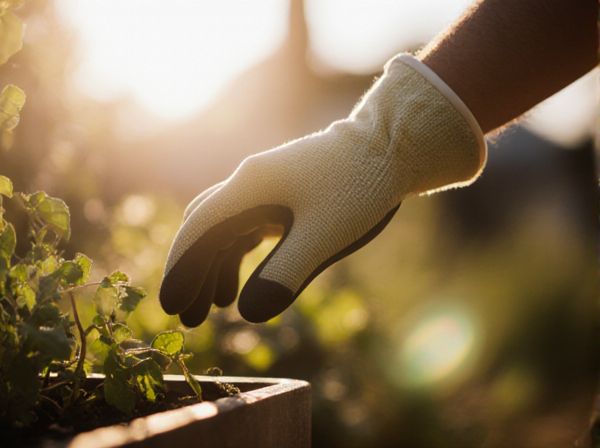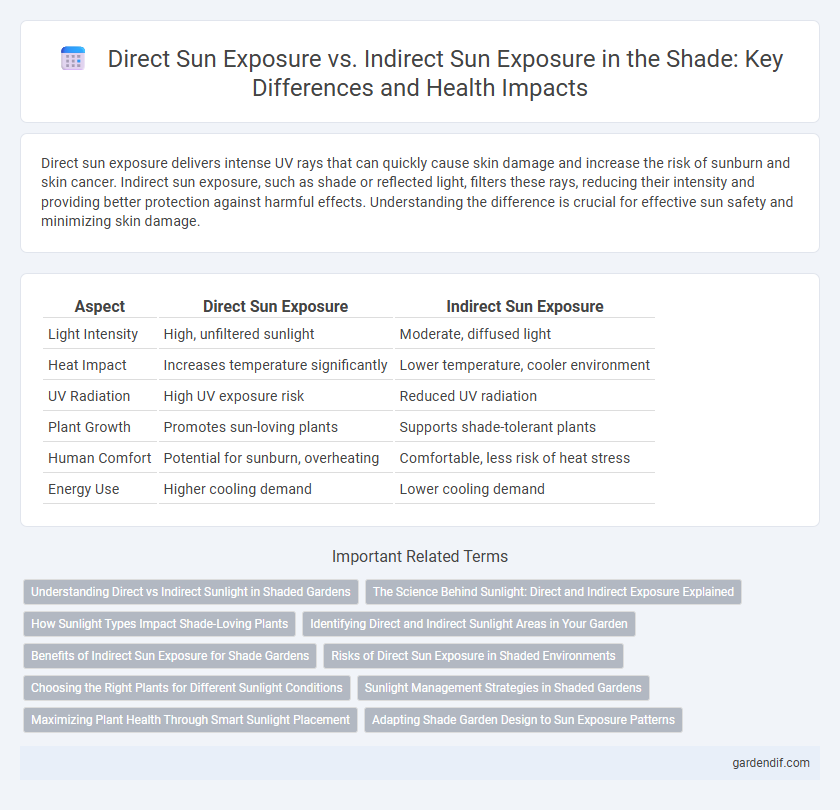
Direct Sun Exposure vs Indirect Sun Exposure Illustration
Direct sun exposure delivers intense UV rays that can quickly cause skin damage and increase the risk of sunburn and skin cancer. Indirect sun exposure, such as shade or reflected light, filters these rays, reducing their intensity and providing better protection against harmful effects. Understanding the difference is crucial for effective sun safety and minimizing skin damage.
Table of Comparison
| Aspect | Direct Sun Exposure | Indirect Sun Exposure |
|---|---|---|
| Light Intensity | High, unfiltered sunlight | Moderate, diffused light |
| Heat Impact | Increases temperature significantly | Lower temperature, cooler environment |
| UV Radiation | High UV exposure risk | Reduced UV radiation |
| Plant Growth | Promotes sun-loving plants | Supports shade-tolerant plants |
| Human Comfort | Potential for sunburn, overheating | Comfortable, less risk of heat stress |
| Energy Use | Higher cooling demand | Lower cooling demand |
Understanding Direct vs Indirect Sunlight in Shaded Gardens
Direct sun exposure refers to sunlight that reaches plants without any obstruction, providing intense light essential for sun-loving species, while indirect sun exposure occurs when sunlight is filtered or diffused through objects like leaves or structures, offering gentler illumination suitable for shade-tolerant plants. In shaded gardens, understanding the differences between these light conditions helps optimize plant selection and placement, ensuring healthy growth and vibrant foliage. Recognizing that indirect sunlight often provides consistent light without the harsh heat stress of direct sun allows gardeners to create environments ideal for shade-loving plants such as ferns, hostas, and impatiens.
The Science Behind Sunlight: Direct and Indirect Exposure Explained
Direct sun exposure involves ultraviolet (UV) rays reaching the skin without obstruction, leading to higher UV intensity and increased risks of sunburn and skin damage. Indirect sun exposure occurs when sunlight is diffused or reflected through surfaces like water, sand, or clouds, resulting in lower UV intensity but still contributing to skin exposure. Understanding the spectrum of UV rays, including UVA and UVB, clarifies how both types of exposure impact skin health and vitamin D synthesis differently.
How Sunlight Types Impact Shade-Loving Plants
Shade-loving plants thrive under indirect sun exposure, which provides diffused light essential for their photosynthesis without causing leaf scorch or dehydration. Direct sun exposure often leads to stress in these plants, triggering wilting, leaf burn, and reduced growth due to intense ultraviolet rays and excessive heat. Understanding the balance between sunlight types is critical for optimizing the health and vibrancy of shade-preferring flora in various garden environments.
Identifying Direct and Indirect Sunlight Areas in Your Garden
Direct sun exposure occurs when sunlight reaches your garden without obstruction, creating areas ideal for sun-loving plants like tomatoes and lavender. Indirect sun exposure, often found under tree canopies or beside structures, provides dappled light ideal for shade-tolerant plants such as ferns and hostas. To accurately identify these zones, observe the garden throughout the day, noting regions with consistent full sunlight versus those with filtered or shadowed light patterns.
Benefits of Indirect Sun Exposure for Shade Gardens
Indirect sun exposure provides optimal light conditions for shade gardens by preventing leaf scorch and moisture loss common with direct sun. Plants in indirect light maintain better hydration and exhibit vibrant foliage colors, promoting healthier growth. This gentle illumination supports photosynthesis without the stress of intense heat, enhancing overall plant resilience in shaded environments.
Risks of Direct Sun Exposure in Shaded Environments
Direct sun exposure in shaded environments increases the risk of ultraviolet (UV) radiation damage, as shade can create a false sense of protection leading to prolonged exposure. UV rays can penetrate through scattered light and reflect off surfaces, causing skin damage, sunburn, and elevating the risk of skin cancer. Proper sun protection, including the use of broad-spectrum sunscreen and protective clothing, remains essential even when under shade to mitigate these risks.
Choosing the Right Plants for Different Sunlight Conditions
Selecting plants based on direct sun exposure versus indirect sun exposure is crucial for optimal growth and health. Succulents, lavender, and sunflowers thrive best in direct sunlight, requiring at least six hours of intense light daily, while ferns, philodendrons, and peace lilies are suited for indirect sunlight, preferring shaded environments with filtered light. Understanding each plant's sunlight tolerance enhances growth, prevents leaf burn, and promotes vibrant foliage.
Sunlight Management Strategies in Shaded Gardens
Direct sun exposure delivers intense, unfiltered ultraviolet rays that can stress shade-tolerant plants, causing leaf scorch and dehydration. Indirect sun exposure provides diffused light, enhancing photosynthesis while reducing heat stress, making it ideal for maintaining plant health in shaded gardens. Effective sunlight management strategies involve optimizing plant placement to balance light intensity, using structures like pergolas or shade cloths to modulate sun exposure, and selecting species adapted to low-light conditions for sustainable garden growth.
Maximizing Plant Health Through Smart Sunlight Placement
Maximizing plant health involves understanding the differences between direct sun exposure, which provides intense light essential for sun-loving species, and indirect sun exposure, ideal for shade-tolerant plants requiring filtered or diffused light. Placing plants according to their light requirements prevents leaf scorch and promotes optimal photosynthesis, resulting in robust growth and vibrant foliage. Strategic sunlight placement tailored to each plant's needs enhances overall garden vitality and reduces stress-related damage.
Adapting Shade Garden Design to Sun Exposure Patterns
Adapting shade garden design to sun exposure patterns requires understanding the differences between direct and indirect sun exposure, as direct sun delivers intense, high UV levels that impact plant choice and placement. Shade gardens in areas with predominantly direct sun exposure benefit from using plants with high UV tolerance and implementing structural shades like pergolas or deciduous trees to moderate sunlight. Areas receiving indirect sun exposure allow for a wider variety of shade-loving plants due to diffused light, promoting lush understory growth and reducing the need for heavy shading structures.
Direct Sun Exposure vs Indirect Sun Exposure Infographic

 gardendif.com
gardendif.com